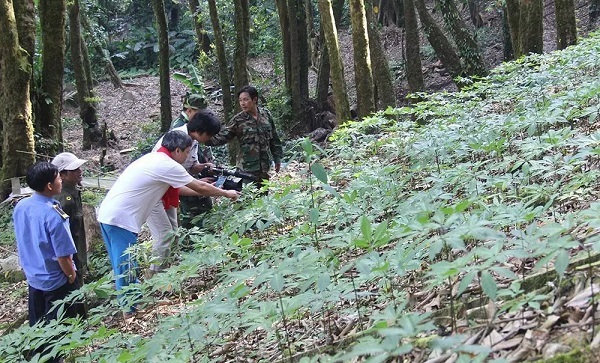In San Moc commune (Vo Nhai district, Thai Nguyen province), khoi nhung (Ardisia silvestris pitard) - a medicinal plant that grows naturally under the forest canopy – has come close to disappearing in nature. But in recent years, growing Ardisia silvestris pitard has brought high earnings for local people.
Nong Quy Duong, Secretary of the Party Committee of Sang Moc commune, told VietNamNet that for each hectare of forest, farmers plant 4,000 Ardisia silvestris pitard trees under the canopy. After one year, they can harvest about 2 tons of dry leaves, earning net profit of about VND300 million (nearly $15,000).
In Dao San commune (Phong Tho district, Lai Chau province), people who plant cardamom have an income of more than VND200 million (nearly $10,000)/hectare, while farmers growing True cardamom in Phin Ngan commune (Bat Xat district, Lao Cai province) earn over VND80 million ($4,000)/hectare. In Dai Dinh commune (Tam Dao, Vinh Phuc province), farmers also earn VND90 million ($4,500)/hectare of Morinda officinalis.
However, these models are small scale while the economic potential under the forest canopy is huge.
Forest is vast, but profit still small
 |
|
|
Vietnam has 14.6 million hectares of both natural and planted forests. It is estimated that the service value of the forest ecosystem in 2020 is about VND38,938 billion, including VND33,400 billion timber and non-timber forest products, VND2,541 billion from forest environment services, and VND2,022 billion from eco-tourism services.
To date, scientists have counted more than 7,000 plant species yielding non-timber products, including 216 species of bamboo, 56 species of rattan, 5,000 species of medicinal plants, 458 species containing essential oil, 473 species containing resinous oil, 113 species of aromatic plants, 800 species of tannins, 93 species containing dying substances, 800 species of orchids… and hundreds of species for food.
A report from the Research Center for Non-timber Forest Products of the Vietnam Academy of Forestry Science shows that the northern mountainous area has more than 5.73 million hectares of forest. This area accounts for over 70% of the total number of plant species yielding non-timber products and over 90% of the country's rare and precious plant species yielding non-timber products.
Some groups of plant species yielding non-timber products have great market demand, play an important role in people's livelihoods, and are key in economic development at present and in the future. They include fiber plants, extracts from plants, plants for food and medicinal and cosmetic plants.
There are up to 4,000 plant species for pharmaceuticals and cosmetics, including 144 rare species in the world such as Lai Chau ginseng, Vu Diep ginseng, wild Himalayan ginseng, wintergreen barberry, Paris polyphylla smith in the Northwest region of Vietnam or Coscinium fenestratum, Fibraurea recisa, Camellia chrysantha, Stephania sinica, Curculigo orchioides, and Morinda officinalis in the Northeast region of Vietnam.
The economy under the forest canopy provides a large source of raw materials for bamboo and rattan processing and paper industry with nearly 1 million tons/year; raw materials for food processing with about 20,000 tons/year; and the pharmaceutical, chemical and cosmetic industries with about 50,000 tons/year.
It is expected that by 2030, demand for non-timber forest products for processing industries of rattan and bamboo, paper, pharmaceuticals, traditional medicine, cosmetics, and essential oils at home and for export will be 1.5 times higher than the current level.
According to incomplete statistics in the 2016-2020 period, the production value of non-timber forest products increased, accounting for 10-15% of the production value of the forestry sector. The annual export value rose by 15% on average, from $350 million in 2016 to more than $800 million in 2020.
It was also reported that economic development under the forest canopy creates a significant source of income, an important livelihood i the household economy (accounting for about 15% of total income).
Economic development under the forest canopy has great potential but the actual benefits are still fragmented, scattered and unplanned. With outdated processing technology, up to 90% of non-timber forest products of Vietnam are raw and semi-processed products. Worse, the export of non-timber forest products is too dependent on the Chinese market through border trade.
How to explore the open "gold mine"?
Economic development under the forest canopy not only contributes to forest protection, soil erosion control, water source protection... but also to livelihoods to help people in mountainous provinces eliminate hunger and reduce poverty. According to experts, when developing economy under the forest canopy, not only trees but also domestic animals can be raised.
Expert Tran Thi Thu Ha from the Forest Research and Development Institute (Thai Nguyen University of Agriculture and Forestry) said that to create the highest efficiency, it is necessary to make development links based on the value chain from planting to the processing of high-value products. This requires practical policies in each locality to attract individuals, households, organizations and businesses to invest in developing economies under the forest canopy while protecting forest resources.
Minister of Agriculture and Rural Development Le Minh Hoan said that developing multi-use forests is a good way to help people make a living.
During his visit to Finland, the Minister saw local people selling a lot of food harvested from forests. In Vietnam, it is reported that people in the mountainous region exploit medicinal plants to sell as raw materials to China at extremely low prices.
He said that the Northwest region of Vietnam has invaluable resources, but we have not yet realized the value of them. It necessary to join hands to "open the door" to wake up the “princess who has been sleeping in the forest for hundreds of years”.
He said the Ministry of Agriculture and Rural Development plans to have projects to develop the economy under the forest canopy in the Northwest region.
Tam An

Vietnam wants to exploit enormous medicinal herb treasure
Northern mountainous people are living with so-called ‘golden mountains’, but still cannot exploit the resources in the most effective way.